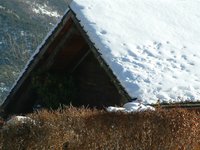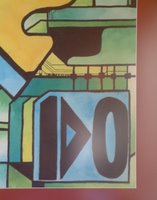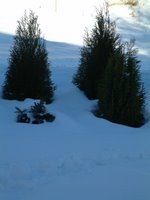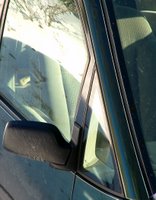Moonbeam drawer, Trisides
The most satisfying side of our Toblerone bars remains the one that says "bite here."
How many triangles do you see?
(Printable version at: www.zidao.com/triside.doc)
“I spy, with my little eye . . .” said a boy to a girl, in the back of my car. The game went on for several minutes, easing the boredom towards the end of a long drive in snowy fog.
An argument ensued: could you spy out and tease your friend with something abstract. For the blue car ahead of us, could you spy “blue” or did it have to be “car”?
As I drove, ignoring the backseat wrangling, I tried to spy triangles, because I knew that our nighttime moonbeam drawers have a triangle drawer. I saw few triangles around me. Their rarity added to my suspicion that there are few of them in our world, far fewer than circles, ovals and rectangles. And yet, the roadside gave me two of the most common triangles in northern countries’ daily lives. To my right, yield signs, and to my left, tall evergreens whose angular outlines we learn to draw as small children.
Colors, textures and forms. This is our visual world, blended to a smooth seamlessness until we start thinking about how the brain works. Of these, most of us are likely to first recall the colors of a scene, then probably the textures, and only after thinking, the forms, or shapes and lines that are part of all that stares back at us.
Moonbeam drawer - The triangle drawer
A secret: the triangle drawer is its name, but when you tug it open, only a small number of things sit in there, quietly, and if you want to get to the hidden compartment, the interesting bit, you have to whisper another name and brush your hand over it in a special way.
But first, the triangle drawer. Oddly, it is square, made from two hugging triangles, and very dark brown. It is hard to open, and at first all we can see are sharp, unpleasant corners inside, like too many elbows in a tight space. Every triangle has three angles. Angles are hard to see correctly from the outside, so we usually look at them from inside the triangle. Step inside and walk towards one of the angles, one where the two lines are close together. There are always at least two like this and sometimes three. You bump your nose on the corner, and your arms don’t fit in the space. If you were a child of long ago and your teacher sent you to the corner of this room you would want to cry at the tight unpleasantness of it, even before you felt assaulted by the injustice of adults. You can’t turn around easily in a triangle corner. People build circular and octagonal rooms for fun, but triangular rooms and houses (as opposed to a-frames) are a nuisance and make us uncomfortable. Triangle bookshelves only work well with three-dimensional triangular books, and there are very few of these in the world, not enough for one shelf.
You can’t turn around easily in a triangle corner. People build circular and octagonal rooms for fun, but triangular rooms and houses (as opposed to a-frames) are a nuisance and make us uncomfortable. Triangle bookshelves only work well with three-dimensional triangular books, and there are very few of these in the world, not enough for one shelf.
Triangles do have their fans, and I don’t mean the folding, fanning kind. The Babylonians fell in love with triangles, as did the Egyptians. Pythagorus the Greek, with his island school where students lived on a diet of beans and numbers, gave triangles a significant place in history. Everyone learns about them.
The best thing that can be said for triangles is that they long ago made themselves appealing to mathematicians, who adopted them.
Let the mathematicians keep the bony old things, I say.
The triside drawer Before your hand tugs at the triangle drawer, in the dark, down under the bedtime covers, run your hand ever so lightly and softly over it. Your fingers feel the outline of the sides of a triangle. It begins to glow, then to hum, as you tap it gently. I spy: a soft gray glow, with glimmers of purple and deep blue, then a little flash of green as the drawer opens.
Before your hand tugs at the triangle drawer, in the dark, down under the bedtime covers, run your hand ever so lightly and softly over it. Your fingers feel the outline of the sides of a triangle. It begins to glow, then to hum, as you tap it gently. I spy: a soft gray glow, with glimmers of purple and deep blue, then a little flash of green as the drawer opens.
This is the triside drawer, where the magic cousin of the triangle lives. And here we have a jumble of delightful objects and ideas that you can pull out in any way you please. Best of all, when we grow tired of thinking about them and we begin to drift off to sleep, they tumble back where they came from, just as quietly, and the drawer slips back where it was. Tomorrow, the mathematicians of the world will still be counting and calculating and trying to outwit their triangles. We’ll play with the light and woolly thoughts the trisides left with us.
Races run around trisides make us laugh because everyone falls over when they have to stop suddenly and change direction to run along another side. Upright trisdies taught people about gravity long before Isaac Newton sat under an apple tree and had a concussion from an apple. They watched birds hop up one side of a roof and down the other side, but even these feather-light little creatures couldn’t manage to hop along the third side.
We began to understand what it meant to have a sense of direction back in the days when we first put sheep in pens, made from stones picked up in the fields. They had three sides because four sides didn’t always meet, nor did circles, but trisides reliably would always eventually meet. Try drawing a free-form square and see if you end up with two sets of parallel lines.
Our ancestors stood on one side of the pen and realized that the other two sides always pointed somewhere. No matter which side they stood on, the other two sides continued to point to the future, to something better than shepherding.

One of my favourite trisides was the brainchild of a Swiss chocolate maker, Herr Tobler, who stirred together honey and almonds to make an excellent nougat, then covered it in chocolate, but not in the form of a bar. For nearly 100 years people have been trying to work out which side to eat first.



1 Comments:
I so enjoy your essays on all sorts of things! I'll be looking for triangles everywhere today!
Post a Comment
<< Home